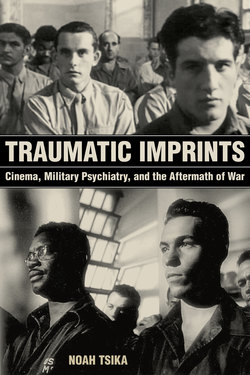Читать книгу Traumatic Imprints - Noah Tsika - Страница 7
На сайте Литреса книга снята с продажи.
ОглавлениеAcknowledgments
Raina Polivka is an ideal editor—encouraging and enlightening—and I begin by thanking her. Raina saw and communicated the promise of this project at a particularly difficult time in my life, and her early support inspired me in more ways than I can possibly explain. It has been a pleasure and a privilege to work with her on this book. At the University of California Press, Zuha Kahn and Elena Bellaart were enormously helpful.
Material support for this project was provided by a PSC-CUNY Award, jointly funded by The Professional Staff Congress and The City University of New York. Additional support came from the Andrew W. Mellon Foundation, which generously provided back-to-back grants.
Clio Unger, my research assistant at the CUNY Graduate Center, helpfully tracked down and photocopied some key articles. I would also like to thank my students at the Graduate Center, especially Colleen O’Shea and Terrence Hunt, and my graduate students at Queens College, especially Juan Antonio Fernandez, Vanessa Dunstan, Michael Bass, and Keith Bevacqua.
Much of the research for this book was conducted at the National Archives and Records Administration’s facility in College Park, Maryland; at the New York Public Library (especially the Manuscripts and Archives Division at the Stephen A. Schwarzman Building and the Schomburg Center for Research in Black Culture); at the Library of Congress; and at the National Library of Medicine, where Leonore Burts, Miriam Meijer, Crystal Smith, and Linda Williams were ideal guides and generous interlocutors. I thank the intrepid archivists who remain committed to the careful preservation and classification of mid-twentieth-century military media, as well as the many staff members (especially Linda) who welcomed me day after day. At the New York University Archives, Danielle Nista was especially helpful.
I have been working on this project, off and on, for over ten years, and I have benefited from the input and expertise of a number of scholars, some of whom carefully read portions of the manuscript: Richard Allen, Michael Bronski, Amalia Córdova, Lee Grieveson, Martin Johnson, Jonathan Kahana, Moya Luckett, Rick Maxwell, Anna McCarthy, Dana Polan, Chris Straayer, Dan Streible, Haidee Wasson, Thomas Waugh, and Joe Wlodarz. True to form, Bronski never hesitated to alert me to any number of obscure films from Hollywood’s classical period (“Quick—turn on TCM! Roz Russell is talking about combat fatigue!”) The late Robert Sklar shaped this work in innumerable ways—including by showing me a 16mm print of John Huston’s Let There Be Light when I was a particularly impressionable first-year graduate student. I hope that I have honored Bob’s astonishing legacy, however modestly, with this book. Jonathan Kahana’s influence is on every page: our conversations, email exchanges, and collaborative projects have been high points of my career. I am tempted to write that Jonathan taught me everything I know about documentary; he has certainly taught me how to be a better writer, a better thinker, and a more rigorous researcher.
Alice Lovejoy and Marlisa Santos, who read and commented on the manuscript multiple times for the press, were amazingly thorough and inspiring, including through the models of their own work. Alice, in particular, challenged me from the very beginning to rethink a series of assumptions, and I am immensely grateful for her meticulous criticism.
My remarkable parents, Mary Tsika and Ronald Tsika, let me stay with them for nearly three months in 2016, as I coped with my own post-traumatic condition, and it was while recovering in their house that I was able to return to this project. Their passion for film—especially documentary—has been a consistent source of inspiration, and their courage to grow is nothing short of awe-inspiring. My big brothers, Aaron Tsika and Adam Tsika, deserve special thanks, as well.
Adam Hobbins, thank you for everything.
This book is the product of two traumas—an attempted armed home invasion that occurred in the immediate wake of campus violence, and the sudden and quite unexpected end of my marriage—and it bears their imprints in ways that only I may be able to recognize. But it took a village to help me cope with the aftermath of a surprise divorce, and I would like to offer heartfelt thanks to the true friends who came to my aid as I was navigating the pain, confusion, and utter humiliation of that moment in my life, all while facing the residual effects of my late-night confrontation with a disturbed gunman: Phoenix Alexander, Max Andrucki, Brandon Arroyo, Lee Bailey, Beau Brinker, Jonathan Buchsbaum, Matthew Crain, Brooke Edge, Murtada Elfadl, Michael Fragoso, Dana Gravesen, Lindsey Green-Simms, David Greven, Kenneth Gyang, Amy Herzog, Sean Jacobs, Nikyatu Jusu, Amanda Ann Klein, Guy Lodge, Moya Luckett, Al Martin, Tara Mateik, Rick Maxwell, Kerry McBroom, Seán McGovern, Ryan McPhee, Michael Morgan, Tyler Morgenstern, ’Șẹgun Ọdẹjimi, Kimani Okearah, Nick Patton, Justine Peres Smith, Christopher Persaud, Nathaniel Rogers, Kieran Scarlett, and Joe Wlodarz. I risk “oversharing” here because I would like to impress upon the reader—as a sort of preview of one of the themes of this book—the possibility of recovery. The possibility.
It’s possible.
Noah Tsika, New York City, April 2018
